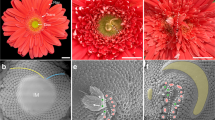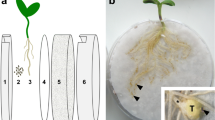Summary
Following severance of the root stele mature bundle-sieve tubes show a rapid wound response, plugging their sieve pores and depositing callose. Close to the blocked sieve tubes the predetermined but still immature bundle sieve tubes differentiate and consist of mature sieve elements 48 hours after wounding. Within a serially sectioned area the existence of lateral sieve pores connecting blocked bundle-sieve tubes with those which matured after wounding could be proved. Wound-sieve tubes are initiated close to the latter, linked to them by lateral sieve pores. The wound-sieve tubes elongate bidirectionally, parallel to the interrupted phloem trace, until a first (towards the cortex) deviating member is established on one end and, on the other, the length of the common course with the bundle is sufficient for assimilate transfer. Presumably, both initiation and elongation of wound-sieve tubes are guided by preexisting plasmodesmata, which later give rise to sieve pores. Eventually the deviating wound-sieve tubes are in close plasmatic contact with those bundle-sieve tubes which mature after wounding and hence, indirectly, with blocked sieve tubes.
One precondition to the restitution of translocation within blocked bundle-sieve tubes is a secondary opening of the plugged sieve pores. The reversibility of callose deposition and the structure of functional pores are discussed.
The model of sequential differentiation for channelling auxin in undifferentiated tissue (Sachs 1975) is compared with the sequential differentiation of wound-sieve tubes.
Similar content being viewed by others
References
Aloni, R., Wolf, A., 1984: Suppressed buds embedded in the bark across the bole and the occurence of their circular vessels inFicus religiosa. Amer. J. Bot.71, 1060–1066.
Anderson R., Cronshaw, J., 1969: The effects of pressure release on the sieve plate pores ofNicotiana. J. Ultrastruct. Res.29, 50–59.
— —, 1970: Sieve element pores inNicotiana pith culture. J. Ultrastruct. Res.32, 458–471.
Behnke, H.-D., 1965: Über das Phloem der Dioscoreaceen unter besonderer Berücksichtigung ihrer Phloembecken. I. Mitteilung: Lichtoptische Untersuchungen zur Struktur der Phloembecken und ihrer Einordnung in das Sproßleitsystem. Z. Pflanzenphysiol.53, 97–125.
—, 1971: The contents of the sieve-plate pores inAristolochia. J. Ultrastruct. Res.36, 493–498.
—,Schulz, A., 1980: Fine structure, pattern of division, and course of wound phloem inColeus blumei. Planta150, 357–365.
Blakely, L. M., Durham, M., Evans, T. A., Blakely, R. M., 1982: Experimental studies on lateral root formation in radish seedling roots. I. General methods, developmental stages, and spontaneous formation of laterals. Bot. Gaz.143, 341–352.
Cronshaw, J., Anderson, R., 1969: Sieve plate pores inNicotiana. J. Ultrastruct. Res.27, 134–148.
— —, 1971: Phloem differentiation in tobacco pith culture. J. Ultrastruct. Res.34, 244–259.
Currier, H. B., Webster, D. H., 1964: Callose formation and subsequent disappearence: Studies in ultrasound stimulation. Plant Physiol.39, 843–847.
Engleman, E. M., 1965: Sieve element ofImpatients sultanii. I. Wound reaction. Ann. Bot. N.S.29, 83–101.
Esau, K., 1965: Anatomy and cytology ofVitis phloem. Hilgardia37, 16–72.
—, 1969: The phloem. In: Handbuch der Pflanzenanatomie, Bd. V, Teil 2 (Zimmermann, W., Ozenda, P., Wulff, H.-D. eds.). Berlin: Gebrüder Bornträger.
Eschrich, W., 1953: Beiträge zur Kenntnis der Wundsiebröhren-Entwicklung beiImpatiens holsti. Planta43, 37–74.
—, 1965: Physiologie der Siebröhrencallose. Planta65, 280–300.
Evert, R. F., 1982: Sieve-tube structure in relation to function. Bio. Sci.32, 789–795.
—,Eschrich, W., Eichhorn, S. E., 1973: P-protein distribution in mature sieve elements ofCucurbita max. Planta109, 193–210.
Feldman, L. J., 1981: Effect of auxin on acropetal auxin transport in roots of corn. Plant Physiol.67, 278–281.
Hughes, J. E., Gunning, B. E. S., 1980: Glutaraldehyde-induced deposition of callose. Can. J. Bot.58, 250–258.
Johnson, R. P. C, 1968: Microfilaments in pores between frozen-etched sieve elements. Planta81, 314–332.
—, 1973: Filaments but no membranous transcellular strands in sieve pores in freeze-etched, translocating phloem. Nature244, 464–466.
Kollmann, R., Dörr, I., Schulz, A., Behnke, H.-D., 1983: Funktionelle Differenzierung der Assimilatleitbahnen. Ber. dtsch. Bot. Ges.196, 117–132.
Kaan-Albest, A. v., 1934: Anatomische und physiologische Unter-suchungen über die Entstehung von Siebröhrenverbindungen. Z. Bot.27, 1–94.
Parthasarathy, M. V., 1975: Sieve element structure. In: Transport in Plants. I. Phloem Transport (Zimermann, M.H., Milburn, J. A., eds.), pp. 3–38 (Encyclopedia of Plant Physiology N.S. 1). Berlin-Heidelberg-New York: Springer.
Pate, J. S., Layezell, D. B., Atkins, C. A., 1980: Transport exchange of carbon, nitrogen and water in the context of whole plant growth and functioning. Case history of a nodulated annual legume. Ber. dtsch. Bot. Ges.93, 243–253.
Robbertse, P. J., McCully, M. E., 1979: Regeneration of vascular tissue in wounded pea roots. Planta145, 167–173.
Sachs, T., 1975: The induction of transport channels by auxin. Planta127, 201–206.
—, 1981: Polarity changes and tissue organization in plants. In: International Cell Biology 1980–1981 (Schweiger, H. G., ed.), pp. 489–496. Berlin-Heidelberg-New York: Springer.
—,Cohen, D., 1982: Circular vessels and the control of vascular differentiation in plants. Differentiation21, 22–26.
Schulz, A., 1986: Wound phloem in transition to bundle phloem in primary roots ofPisum sativum L. I. Development of bundle-leaving wound-sieve tubes. Protoplasma130, 12–26.
Sjolund, R. D., Shih, C. Y., Jensen, K. G., 1983: Freeze-fracture analysis of phloem structure in plant tissue cultures. III. P-protein, sieve area pores, and wounding. J. Ultrastruct. Res.82, 198–211.
Walsh, M. A., 1980: Preservation of the tonoplast in metaphloem sieve elements of embryonic roots ofZea mays. J. Ultrastruct. Res.46, 557–565.
Author information
Authors and Affiliations
Rights and permissions
About this article
Cite this article
Schulz, A. Wound phloem in transition to bundle phloem in primary roots ofPisum sativum L.. Protoplasma 130, 27–40 (1986). https://doi.org/10.1007/BF01283328
Received:
Accepted:
Issue Date:
DOI: https://doi.org/10.1007/BF01283328




